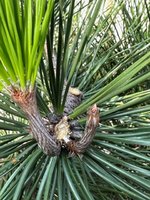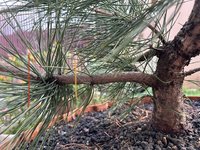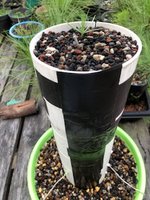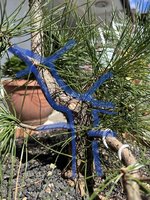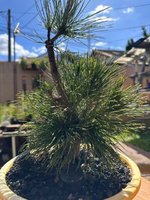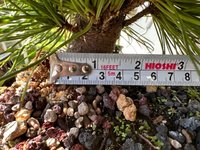Benny Lu
Sapling
Hello
I planted several JBP seeds in Q4 2019. Still have several trees from that batch today.
I think its time to thin out, so the interior could get some light.
Been learning from this forum (especially the 6 years contest), youtube, Jonas Blog, and google.
I live in Bandung, West Java Indonesia. Climate is warm and humid all year around.
We only have two seasons here:
- dry season, less rain
- rainy season, the monsoon
This tree below was planted from seed in December 2019. Moved to this huge pot in mid 2020, and been there since.
It’s 117cm height from the base, and the apex candle still pushing.

the top section is 75cm long (A)
previous season growth in B ? Different needle pattern.
All this will become sacrificial branch.

the base was shaded by the top portion of the tree and the pot itself. So I cut the pot last week.

I want to preserve the interior buds for future use, and keep the existing big low branch as sacrifice.



- is it save to cutback the unused branch now? Because winter/spring is non existing here, and I’ve read about timing, so…
- will it bud back? Considering its 3,5 years old
- or should I go with needle plucking?
- make it cascade using the low long branch?
any suggestions will be much appreciated
I planted several JBP seeds in Q4 2019. Still have several trees from that batch today.
I think its time to thin out, so the interior could get some light.
Been learning from this forum (especially the 6 years contest), youtube, Jonas Blog, and google.
I live in Bandung, West Java Indonesia. Climate is warm and humid all year around.
We only have two seasons here:
- dry season, less rain
- rainy season, the monsoon
This tree below was planted from seed in December 2019. Moved to this huge pot in mid 2020, and been there since.
It’s 117cm height from the base, and the apex candle still pushing.

the top section is 75cm long (A)
previous season growth in B ? Different needle pattern.
All this will become sacrificial branch.

the base was shaded by the top portion of the tree and the pot itself. So I cut the pot last week.

I want to preserve the interior buds for future use, and keep the existing big low branch as sacrifice.



- is it save to cutback the unused branch now? Because winter/spring is non existing here, and I’ve read about timing, so…
- will it bud back? Considering its 3,5 years old
- or should I go with needle plucking?
- make it cascade using the low long branch?
any suggestions will be much appreciated





